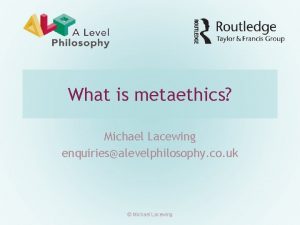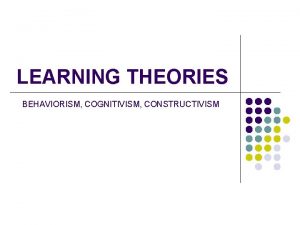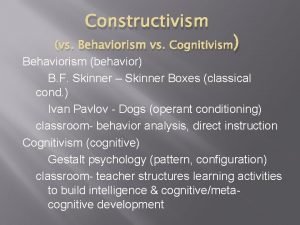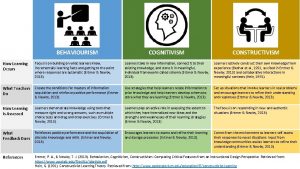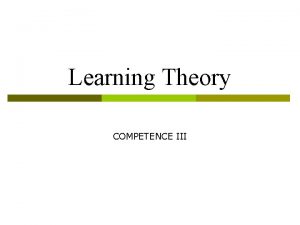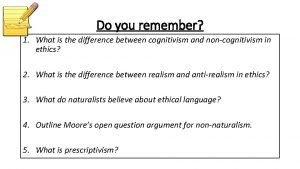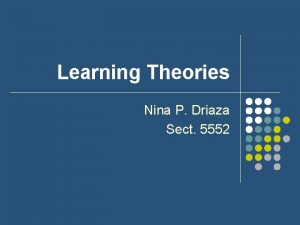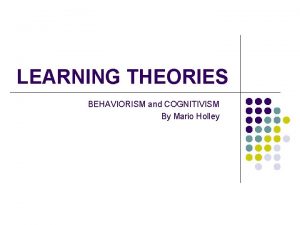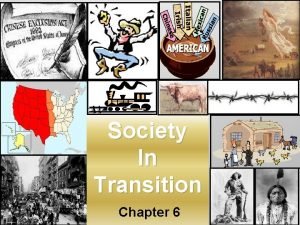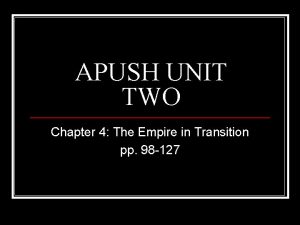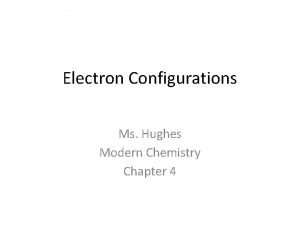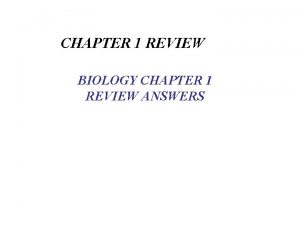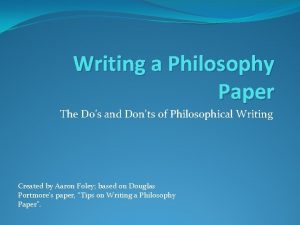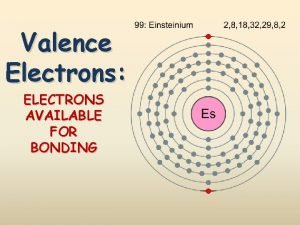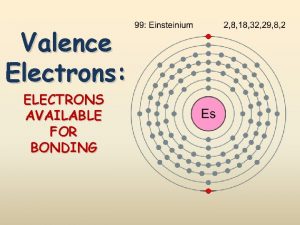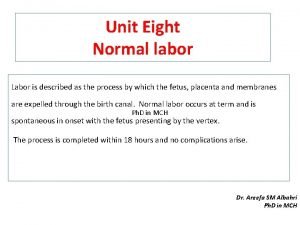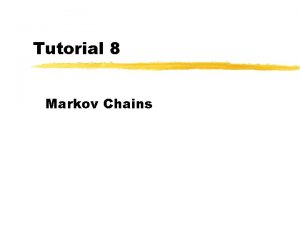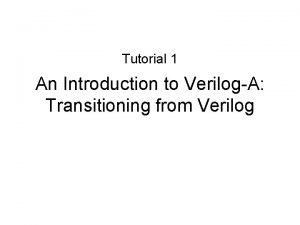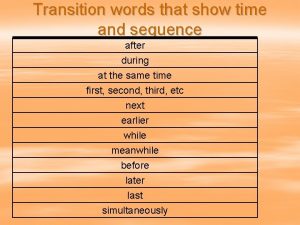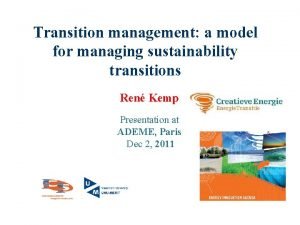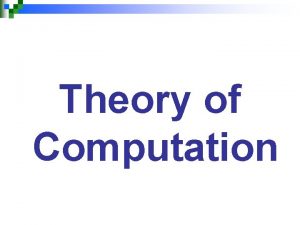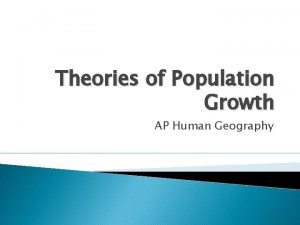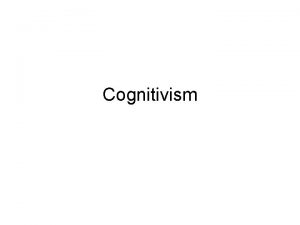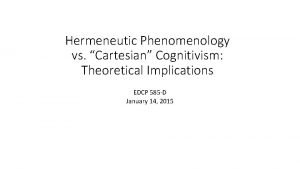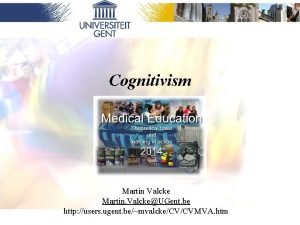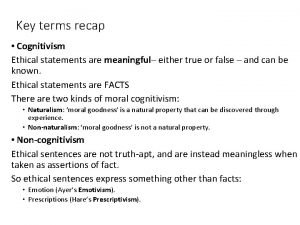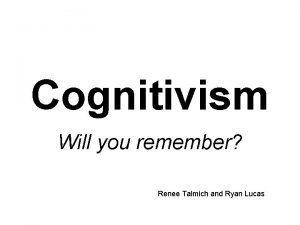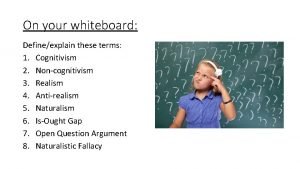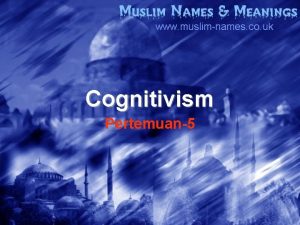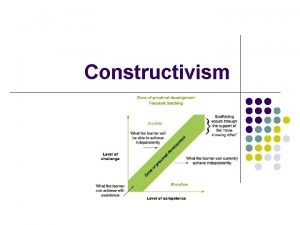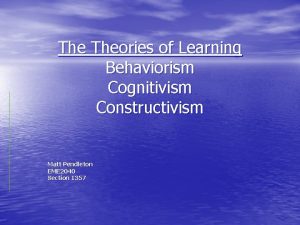CHAPTER 6 TRANSITION TO MODERN COGNITIVISM Chapter 6
























































- Slides: 56

CHAPTER 6 TRANSITION TO MODERN COGNITIVISM

Chapter 6 Outline

Chapter 6 Outline I. This Chapter II. Hebb’s Theory III. From Behaviorism to Cognitivism IV. Mechanistic Behaviorism V. Tolman's Purposive Behaviorism VI. Gestalt Psychology: Basic Beliefs VII. Metaphors in Psychology Guy R. Lefrançois Theories of Human Learning: What the Professor Said 6 e Ch. 6: Transition to Modern Cognitivism 3

Hebb’s Theory

Higher Mental Processes • Higher mental processes = thinking or thought processes • Mediating processes • According to Hebb, ““Everything you know about another person’s thoughts or feelings is inferred from behavior. Knowledge of behavior is factual. Knowledge of mental processes is theoretical, or inferential” Guy R. Lefrançois Theories of Human Learning: What the Professor Said 6 e Ch. 6: Transition to Modern Cognitivism 5

Donald Olding Hebb (1904 – 1985) Born in a tiny town in Nova Scotia Wanted to be a novelist Both parents were physicians Failed 11 th grade with most of his classmates Struggled to earn his degree from Dalhoussie University • Earned his Ph. D. from Harvard • Held appointments at Harvard, at the Montreal Neurological Institute, and at Queen’s University in Kingston, Ontario • • • Guy R. Lefrançois Theories of Human Learning: What the Professor Said 6 e Ch. 6: Transition to Modern Cognitivism 6

The Physiology of Learning • According to Hebb, psychology needs to take into account the functioning of the nervous system— and especially the brain. • Other behaviorists deliberately avoided speculation about what the human physiological systems do. • Hebb proposed that mental processes that intervene between stimulus and response can be understood and described as neurological events. Guy R. Lefrançois Theories of Human Learning: What the Professor Said 6 e Ch. 6: Transition to Modern Cognitivism 7

The Central Nervous System • Neurons – cell body (soma) – dendrites – axon • Transmission among neurons is from axon ends across the synaptic cleft, which is the separation between the axon end and the dendrites of an adjacent cell. • Important neurotransmitters include dopamine, serotonin, acetylcholine, and norepinephrine. Guy R. Lefrançois Theories of Human Learning: What the Professor Said 6 e Ch. 6: Transition to Modern Cognitivism 8

Idealized Representation of Two Neurons a = dendrite b = soma (cell body) c = axon Guy R. Lefrançois d = synaptic cleft e = terminal bouton Theories of Human Learning: What the Professor Said 6 e Ch. 6: Transition to Modern Cognitivism 9

Hebb’s Assumptions • The Hebb Rule: Repeated transmission of impulses between two neurons leads to permanent facilitation of transmission between these cells. • Separate neurons can fire in a circular pattern so that the original neuron is eventually reactivated by another neuron in the pattern (a cell assembly). • Simultaneously active cell assemblies become associated so that they can activate each other mutually (a phase sequence). Guy R. Lefrançois Theories of Human Learning: What the Professor Said 6 e Ch. 6: Transition to Modern Cognitivism 10

Cell Assembly Cell assemblies consist of activity in a large number of related neurons. They correspond to relatively simple input Guy R. Lefrançois Theories of Human Learning: What the Professor Said 6 e Ch. 6: Transition to Modern Cognitivism 11

Phase Sequence Schematic representation of a phase sequence: a, b, c, d, and e can be thought of as cell assemblies. A phase sequence is equivalent to a concept and may consist of activity in a large number of related neurons. Guy R. Lefrançois Theories of Human Learning: What the Professor Said 6 e Ch. 6: Transition to Modern Cognitivism 12

Neurological Changes in Learning • For Hebb, higher mental processes (thinking) involve activity in neural assemblies. • This activity must take the form of neurons arranged in such a way that they can keep reactivating one another in patterns he calls cell assemblies. • Hebb’s notion of cell assemblies plays an increasingly important role in current psychological research and theory (i. e. , computer -based neural networks; language learning; amnesia; and, memory). Guy R. Lefrançois Theories of Human Learning: What the Professor Said 6 e Ch. 6: Transition to Modern Cognitivism 13

The Neurology of Reactivity and Plasicity • Reactivity refers to the capacity of the organism to react to external stimuli. • Plasticity is the property of the organism that allows it to change as a function of repeated stimulation. – unused neural connections often disappear – sensitization leads to long-term potentiation (LTP) – habituation leads to long-term depression (LTD) Guy R. Lefrançois Theories of Human Learning: What the Professor Said 6 e Ch. 6: Transition to Modern Cognitivism 14

Higher Mental Processes • The Hebb Rule – repetition has a facilitating effect on further neural activity • Co-Activation of Cell Assemblies – if two cell assemblies are repeatedly active at the same time, an association between the two will tend to form • Forming Associations – the formation of associations between events that are in temporal contiguity Guy R. Lefrançois Theories of Human Learning: What the Professor Said 6 e Ch. 6: Transition to Modern Cognitivism 15

Guy R. Lefrançois Theories of Human Learning: What the Professor Said 6 e Ch. 6: Transition to Modern Cognitivism 16

Set and Attention • Set refers to selectivity among responses • Attention refers to selectivity among input • Set and attention are central processes in learning and perception. • According to Hebb, both set and attention are functions of the pre-activation of specific cell assemblies. Guy R. Lefrançois Theories of Human Learning: What the Professor Said 6 e Ch. 6: Transition to Modern Cognitivism 17

Educational Applications of Hebb's Theory • Set and attention are especially important for teachers. • Arousal is an essential condition of learning – Too high of an arousal level results in anxiety or panic – Too low of an arousal level results in boredom, lethargy, or sleep • Student motivation Guy R. Lefrançois Theories of Human Learning: What the Professor Said 6 e Ch. 6: Transition to Modern Cognitivism 18

An Appraisal of Hebb's Theory • A significant departure from the more traditional S-R theories due to its concern mainly with internal neurological events • Hebb brought a consideration of physiological mechanisms back into the study of learning and behavior • His work on arousal theory gives him an important position as a motivational theorist • Hebb’s work on sensory deprivation had an important influence on research in learning • He significantly influenced research in neuroscience and on brain-based learning, as well as the study of emotions, memory, perception, and human development Guy R. Lefrançois Theories of Human Learning: What the Professor Said 6 e Ch. 6: Transition to Modern Cognitivism 19

From Behaviorism to Cognitivism Guy R. Lefrançois Theories of Human Learning: What the Professor Said 6 e Ch. 6: Transition to Modern Cognitivism

From Behaviorism to Cognitivism • Hebb, Tolman, and others like them influenced the gradual transition from behaviorism to congnitivism. • The main difference between these two points of view has to do with disagreement over whether external behaviors can be used to make valid inferences about underlying mental states. • Hebb and Tolman were considered neobehaviorists. Guy R. Lefrançois Theories of Human Learning: What the Professor Said 6 e Ch. 6: Transition to Modern Cognitivism 21

Mechanistic Behaviorism Guy R. Lefrançois Theories of Human Learning: What the Professor Said 6 e Ch. 6: Transition to Modern Cognitivism

Mechanistic Behaviorism • Emphasize and try to understand the predictable aspects of human behavior—in other words, its machinelike qualities ( • Arose largely as a reaction to the more mentalistic approaches • Looks for relationships between response consequences and behavior • Searches for an understanding of how contiguity of stimuli, responses, and response consequences are important in determining behavior • Reductionistic approaches try explaining behavior by analyzing it at a molecular level Guy R. Lefrançois Theories of Human Learning: What the Professor Said 6 e Ch. 6: Transition to Modern Cognitivism 23

Tolman's Purposive Behaviorism Guy R. Lefrançois Theories of Human Learning: What the Professor Said 6 e Ch. 6: Transition to Modern Cognitivism

Tolman's Purposive Behaviorism • Cognitivism is an approach in psychology that is concerned more with decision making, thinking, problem solving, imagining, and related topics, than solely, or primarily, with observable behavior. • One of the early roots of cognitivism is German Gestalt psychology. Guy R. Lefrançois Theories of Human Learning: What the Professor Said 6 e Ch. 6: Transition to Modern Cognitivism 25

Perception with incomplete data. It looks like a triangle, and most people will perceive it as such. But it’s really just three lines that don’t quite meet Guy R. Lefrançois Theories of Human Learning: What the Professor Said 6 e Ch. 6: Transition to Modern Cognitivism 26

Edward Chace Tolman (1886 – 1959) Guy R. Lefrançois Theories of Human Learning: What the Professor Said 6 e Ch. 6: Transition to Modern Cognitivism

Edward Chace Tolman • Born into a Quaker family • Received a B. S. in electrochemistry from the Massachusetts Institute of Technology in 1911; an M. A. in and a Ph. D. in psychology from Harvard • Heavily influenced by the writings of John B. Watson as well as the new psychological ideas of the Gestalt psychologists • Taught at Northwestern, University of California at Berkeley, University of Chicago, and Harvard • Served as president of the American Psychological Association • His writings are filled with whimsy and anecdotes, and he wrote somewhat disparagingly about his own theorizing and research Guy R. Lefrançois Theories of Human Learning: What the Professor Said 6 e Ch. 6: Transition to Modern Cognitivism 28

Do Rats Have Purpose? • Tolman claimed the evidence is convincing • Blocked Path Study • Learning involves the development of cognitive maps, internal representations of relationships between goals and behaviors as well as knowledge of the environment where the goals are to be found • An Expectations Study • A Place Learning Study • A Latent Learning Experiment Guy R. Lefrançois Theories of Human Learning: What the Professor Said 6 e Ch. 6: Transition to Modern Cognitivism 29

Blocked Path Study In the Tolman and Honzik (1930) blocked-path study, rats that had learned this maze almost invariably selected path 3 when path 1 was blocked at B. It seemed they somehow knew that the barrier at B also blocked the much shorter path 2. Guy R. Lefrançois Theories of Human Learning: What the Professor Said 6 e Ch. 6: Transition to Modern Cognitivism 30

Guy R. Lefrançois Theories of Human Learning: What the Professor Said 6 e Ch. 6: Transition to Modern Cognitivism 31

A Place Learning Study Place or direction learning in rats. In the Tolman, Ritchie, and Kalish (1946) study, rats learned a simple maze with an indirect path to the goal. In the second part of the experiment, the position of the goal and of the starting area remained the same, but the original path was blocked and 18 new paths were available. Guy R. Lefrançois Theories of Human Learning: What the Professor Said 6 e Ch. 6: Transition to Modern Cognitivism 32

What is Purposive Behaviorism? • According to Tolman, the rat’s learning and behavior appear to be purposeful • Both animals and humans develop cognitive maps. • Animal mental maps are not quite like human mental maps though. Guy R. Lefrançois Theories of Human Learning: What the Professor Said 6 e Ch. 6: Transition to Modern Cognitivism 33

Educational Implications and Summary Principles of Tolman's System • Behavior is purposive • Behavior is cognitive • Reinforcement establishes and confirms expectancies • A theory of purposive behaviorism is molar, not reductionist • Expectancies develop as a function of exposure to situations in which reinforcement is possible (sign -significate relationships) Guy R. Lefrançois Theories of Human Learning: What the Professor Said 6 e Ch. 6: Transition to Modern Cognitivism 34

An Appraisal of Tolman's Purposive Behaviorism • One of Tolman’s important and often overlooked contributions to the development of psychology relates to his use of mazes in studies of rat behavior. • Maze learning provides an important way of studying memory. • Tolman’s theory emphasizes the importance of cognitive variables such as expectancies. • Tolman’s position might be faulted for a certain inconsistency or lack of clarity. • Tolman’s thinking reflects something of both schools, behaviorism and cognitivism. Guy R. Lefrançois Theories of Human Learning: What the Professor Said 6 e Ch. 6: Transition to Modern Cognitivism 35

Gestalt Psychology: Basic Beliefs Guy R. Lefrançois Theories of Human Learning: What the Professor Said 6 e Ch. 6: Transition to Modern Cognitivism

Gestalt Psychology: Basic Beliefs • Gestalt psychology is a forerunner of contemporary cognitive psychology • Two main beliefs: – the whole is greater than the sum of its parts – people solve problems through insight rather than through trial and error Guy R. Lefrançois Theories of Human Learning: What the Professor Said 6 e Ch. 6: Transition to Modern Cognitivism 37

Insight versus Trial and Error • Insight is the cornerstone of Gestalt psychology. • Insight means solving a problem by perceiving relationships among all the important elements of the situation. • Insightful thinking requires a mental reorganization of problem elements and recognition of the correctness of the new organization. Guy R. Lefrançois Theories of Human Learning: What the Professor Said 6 e Ch. 6: Transition to Modern Cognitivism 38

Gestalt Means "Whole" • Gestalt is German for whole; hence the name for this approach to psychology. • The founders and popularizers of the Gestalt school were Wertheimer, Köhler, and Koffka. • Gestalt psychology is closely linked with studies of perception and the formulation of laws of perceptual organization such as: prȁgnanz, closure, continuity, similarity, and proximity. Guy R. Lefrançois Theories of Human Learning: What the Professor Said 6 e Ch. 6: Transition to Modern Cognitivism 39

The Laws of Perception • Behavior cannot be understood through its parts —that it cannot be reduced to isolated sensations or to distinct stimuli and responses. • The whole (the Gestalt) is different from its isolated parts. • Laws of perceptual organization: – Prägnanz – Closure – Continuity – Similarity – Proximity Guy R. Lefrançois Theories of Human Learning: What the Professor Said 6 e Ch. 6: Transition to Modern Cognitivism 40

Closure A tendency to perceive incomplete objects (or thoughts) as being complete. The figures tend to be perceived as a triangle and a square, rather than as individual lines that don’t meet. Guy R. Lefrançois Theories of Human Learning: What the Professor Said 6 e Ch. 6: Transition to Modern Cognitivism 41

Continuity A tendency to perceive things as being continuous. The lines in (a) tend to be perceived as a straight line running through a curved one, rather than as a set of semicircles as in (b). Guy R. Lefrançois Theories of Human Learning: What the Professor Said 6 e Ch. 6: Transition to Modern Cognitivism 42

Similarity A tendency to perceive similar input as belonging together. The figure is seen as 4 rows of identical letters rather than as 10 columns of different letters Guy R. Lefrançois Theories of Human Learning: What the Professor Said 6 e Ch. 6: Transition to Modern Cognitivism 43

Proximity A tendency to perceive things that are close together as belonging together. Part a is seen as four sets of curved lines; b is seen as three faces. Guy R. Lefrançois Theories of Human Learning: What the Professor Said 6 e Ch. 6: Transition to Modern Cognitivism 44

Gestalt Views of Learning and Memory • Learning results in the formation of memory traces. • Learned material, like any perceptual information, tends to achieve the best structure possible relative to the laws of perceptual organization. • What is remembered is not always what was learned or perceived, but it is often a better gestalt than the original. • Leveling • Sharpening • Normalizing Guy R. Lefrançois Theories of Human Learning: What the Professor Said 6 e Ch. 6: Transition to Modern Cognitivism 45

Leveling A tendency toward symmetry, toward reducing abnormalities and peculiarities Guy R. Lefrançois Theories of Human Learning: What the Professor Said 6 e Ch. 6: Transition to Modern Cognitivism 46

Sharpening A tendency to emphasize the distinctiveness of a pattern. Guy R. Lefrançois Theories of Human Learning: What the Professor Said 6 e Ch. 6: Transition to Modern Cognitivism 47

Normalizing Successive reproductions of the same stimulus object over a period of time become progressively more like something familiar and hence, something “normal. ” Guy R. Lefrançois Theories of Human Learning: What the Professor Said 6 e Ch. 6: Transition to Modern Cognitivism 48

Beyond Perception: The Behavioral Field • The world of “direct experience, ” is important for understanding an individual’s behavior. • The Lake of Constance • The Behavioral Field–personal view of what is real • Appearance versus Reality Guy R. Lefrançois Theories of Human Learning: What the Professor Said 6 e Ch. 6: Transition to Modern Cognitivism 49

Gestalt Psychology and Modern Cognitivism • Gestalt psychology is considered the beginning of contemporary cognitive psychology for two main reasons: – its concern with perception, awareness, problem solving, and insight – it rejected behaviorism for being overly mechanistic, incomplete, and unsuitable for explaining higher mental processes • However, Gestalt psychology and contemporary cognitivism represent different interests and different approaches. Guy R. Lefrançois Theories of Human Learning: What the Professor Said 6 e Ch. 6: Transition to Modern Cognitivism 50

Educational Implications of Gestalt Psychology • Gestalt psychology presents a dramatic contrast to some of the more behavioristic approaches in at least two ways: – People learn through insight, not through trial and error – Psychology should concentrate on the molar rather than the molecular aspects of learning • The Gestalt perspective supports what is termed constructivism rather than direct teaching Guy R. Lefrançois Theories of Human Learning: What the Professor Said 6 e Ch. 6: Transition to Modern Cognitivism 51

Gestalt Psychology: An Appraisal • an important reaction against the introspectionism and the behaviorism that came to dominate much of American psychology in the first half of the 20 th century • is not especially useful for predicting or explaining behavior • criticized for simply describing rather than explaining • continues to have useful applications in counseling and therapy • is highly thought provoking • contributed significantly to the development of later cognitive theories • provided psychology with the beginnings of a new metaphor Guy R. Lefrançois Theories of Human Learning: What the Professor Said 6 e Ch. 6: Transition to Modern Cognitivism 52

Metaphors in Psychology Guy R. Lefrançois Theories of Human Learning: What the Professor Said 6 e Ch. 6: Transition to Modern Cognitivism

Metaphors in Psychology • A metaphor is a comparison. • Perhaps the most common of all current metaphors for human cognition is the computer, from which psychology draws notions of humans as information-processing units. • Psychologists create cognitive models that speak of processing, storing, retrieving, input, output, etc. Guy R. Lefrançois Theories of Human Learning: What the Professor Said 6 e Ch. 6: Transition to Modern Cognitivism 54

Metaphors in Behaviorism • Hull, for example, used machine models of human functioning, describing his theory as the “robot approach. ” • Tolman’s view of human learning explored the metaphor of cognitive maps and hypotheses. • Skinner’s principal metaphor is a Darwinian evolutionary one in that as species survive or die out as a function of natural pressures interacting with “fitness. ” Guy R. Lefrançois Theories of Human Learning: What the Professor Said 6 e Ch. 6: Transition to Modern Cognitivism 55

Metaphors in Cognitivism • Cognitive psychology is a psychology of metaphors. • All theoretical cognitive concepts—for example, operations, short-term and long-term memory, neural networks—are metaphors. • Metaphors in psychology are not simply comparisons meant to evoke images and feelings, as might metaphors in poetry. Rather, they are meant to explain, to illustrate, and to predict. Guy R. Lefrançois Theories of Human Learning: What the Professor Said 6 e Ch. 6: Transition to Modern Cognitivism 56
 Cognitivism in ethics
Cognitivism in ethics Moral agency
Moral agency Difference between cognitivism and constructivism
Difference between cognitivism and constructivism When is cognitivism beneficial for learners
When is cognitivism beneficial for learners Cognitivism vs constructivism
Cognitivism vs constructivism Ertmer and newby 2013
Ertmer and newby 2013 Behaviorism cognitive and constructivism
Behaviorism cognitive and constructivism Non cognitivism examples
Non cognitivism examples Cognitivism
Cognitivism Sibernetik adalah
Sibernetik adalah Normative ethics
Normative ethics Difference between behaviorism and cognitivism pdf
Difference between behaviorism and cognitivism pdf Behaviorism and cognitivism
Behaviorism and cognitivism Cognitivism
Cognitivism Chapter 22 transition to parenthood
Chapter 22 transition to parenthood Chapter 6 american society in transition
Chapter 6 american society in transition Intolerable acts
Intolerable acts Chapter 22 origin of modern astronomy answer key
Chapter 22 origin of modern astronomy answer key Modern chemistry chapter 9 review answers
Modern chemistry chapter 9 review answers Trinitrogen monosulfide formula
Trinitrogen monosulfide formula Modern chemistry chapter 15
Modern chemistry chapter 15 Chapter 14 review acids and bases section 1
Chapter 14 review acids and bases section 1 Chapter 13 review ions in aqueous solutions
Chapter 13 review ions in aqueous solutions Chapter 12 review solutions answer key
Chapter 12 review solutions answer key A series of coordinated related multiple projects
A series of coordinated related multiple projects A series of coordinated related multiple projects
A series of coordinated related multiple projects Johannes kepler
Johannes kepler Modern chemistry chapter 4
Modern chemistry chapter 4 Chapter 17 section 2 modern classification answer key
Chapter 17 section 2 modern classification answer key Chapter 1 the science of biology vocabulary review
Chapter 1 the science of biology vocabulary review Economics chapter 2 section 3 assessment answers
Economics chapter 2 section 3 assessment answers Zimmerman-traxler transition state model
Zimmerman-traxler transition state model Transition words for philosophy papers
Transition words for philosophy papers What element is nonmetallic period 3 atomic mass 32
What element is nonmetallic period 3 atomic mass 32 Valence electrons for transition metals
Valence electrons for transition metals Group with 6 valence electrons
Group with 6 valence electrons Woodward fieser rule
Woodward fieser rule How do you lead into a quote
How do you lead into a quote Hypertonic vs hypotonic uterine dysfunction
Hypertonic vs hypotonic uterine dysfunction Markov chains tutorial
Markov chains tutorial Transition veriloga
Transition veriloga Cause and effect transition words
Cause and effect transition words Transition sequence words
Transition sequence words Sixth grade transition words
Sixth grade transition words Transition words とは
Transition words とは Transition approach
Transition approach 3 ebenen der transition
3 ebenen der transition Transition bibliographique
Transition bibliographique Transition standards alabama
Transition standards alabama Descriptive essay transition words
Descriptive essay transition words Transition headline
Transition headline What is a transition headline
What is a transition headline Transition to thesis example
Transition to thesis example Transition graph in toc
Transition graph in toc Carrying capacity ap human geography
Carrying capacity ap human geography 10 uses of transition elements
10 uses of transition elements Duchscher transition shock model
Duchscher transition shock model
